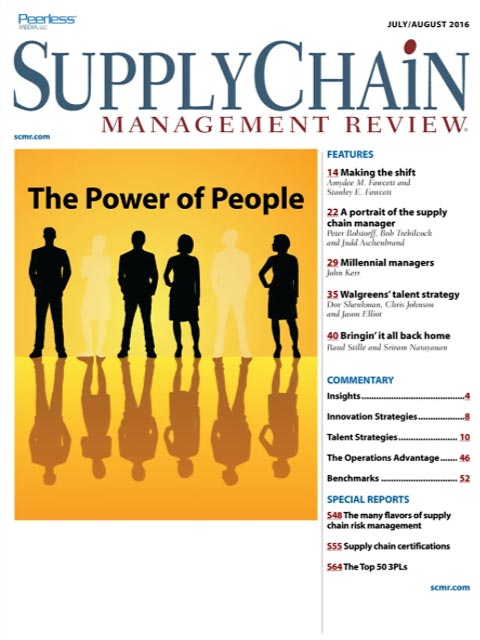Sorry, but your login has failed. Please recheck your login information and resubmit. If your subscription has expired, renew here.
July-August 2016
What’s the difference between us and our competitors? Our people!” I can’t think of an organization that doesn’t publicly state that its people are its most important asset. Yet, anyone who has been in the workforce for any length of time knows that when the rubber hits the road—or something else hits the fan—people are usually the first casualty of cost cutting. It’s far easier to free up your talent for “other opportunities” than it is to close a plant or sell a fleet of trucks. Browse this issue archive.Need Help? Contact customer service 847-559-7581 More options
There are many faces of supply chain risk in today’s global business environment, where anything from a natural disaster to supplier insolvency to geopolitical turmoil can temporarily or permanently disrupt the manufacturing and/or transport of goods. Add quality and safety challenges, regulatory and environmental compliance, and even economic changes like fluctuating exchange rates to the list, and it’s easy to see why risk should be a top-of-mind issue for supply chain managers.
While some supply chain disruptions are identified and addressed quickly and without much fanfare, others receive national attention. In April, for example, Toyota, Honda, Sony and other major firms encountered supply disruptions in the aftermath of multiple earthquakes in Japan.
“The earthquakes on Thursday and Saturday, which killed at least 41 people, reflected the vulnerability of Japanese companies to supply chain disruptions caused by natural disasters,” Reuters reported following the event, “and also highlighted the ‘just in time’ philosophy pioneered by Toyota and followed by many others.”
 |
This complete article is available to subscribers
only. Click on Log In Now at the top of this article for full access. Or, Start your PLUS+ subscription for instant access. |
SC
MR
Sorry, but your login has failed. Please recheck your login information and resubmit. If your subscription has expired, renew here.
July-August 2016
What’s the difference between us and our competitors? Our people!” I can’t think of an organization that doesn’t publicly state that its people are its most important asset. Yet, anyone who has been in the… Browse this issue archive. Access your online digital edition. Download a PDF file of the July-August 2016 issue.
 |
Download Article PDF |
There are many faces of supply chain risk in today's global business environment, where anything from a natural disaster to supplier insolvency to geopolitical turmoil can temporarily or permanently disrupt the manufacturing and/or transport of goods. Add quality and safety challenges, regulatory and environmental compliance, and even economic changes like fluctuating exchange rates to the list, and it's easy to see why risk should be a top-of-mind issue for supply chain managers.
While some supply chain disruptions are identified and addressed quickly and without much fanfare, others receive national attention. In April, for example, Toyota, Honda, Sony and other major firms encountered supply disruptions in the aftermath of multiple earthquakes in Japan.
“The earthquakes on Thursday and Saturday, which killed at least 41 people, reflected the vulnerability of Japanese companies to supply chain disruptions caused by natural disasters,” Reuters reported following the event, “and also highlighted the ‘just in time' philosophy pioneered by Toyota and followed by many others.”
 |
SUBSCRIBERS: Click here to download PDF of the full article. |
SC
MR

Latest Supply Chain News
Latest Podcast

 Explore
Explore
Latest Supply Chain News
- 2024 Warehouse/DC Operations Survey: Technology adoption on the rise
- Benchmarking the complexity of ESG reporting
- Looking back at NextGen 2024
- The Corporate Sustainability Due Diligence Directive
- How to make your CFO a supply chain superfan
- AI is moving omnichannel closer to the customer
- More latest news
Latest Resources

Subscribe

Supply Chain Management Review delivers the best industry content.

Editors’ Picks





